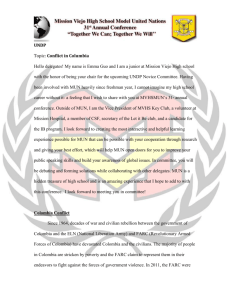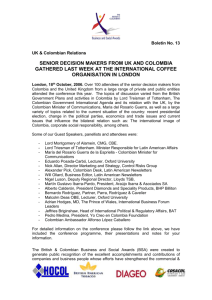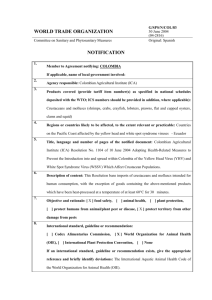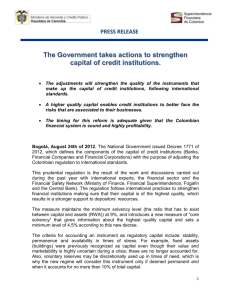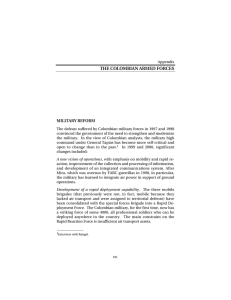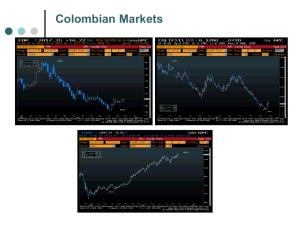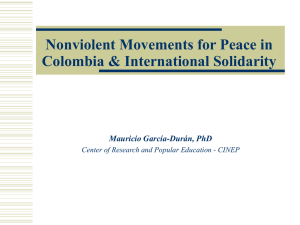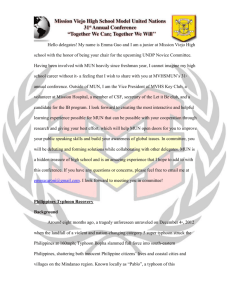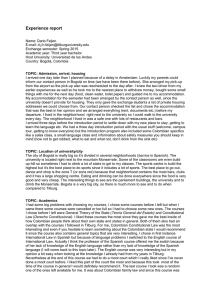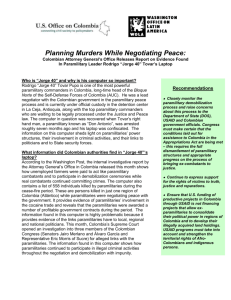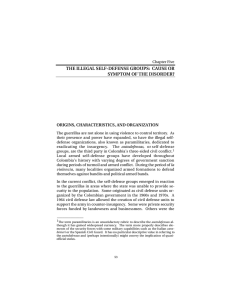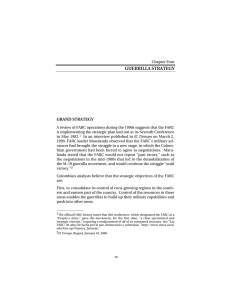Colombia: The Armed Conflict
advertisement
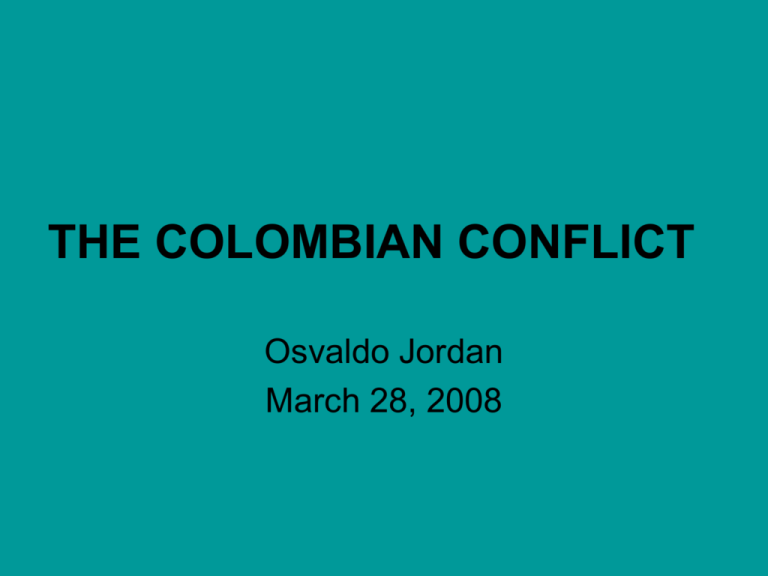
THE COLOMBIAN CONFLICT Osvaldo Jordan March 28, 2008 WHO ARE THE ACTORS? • • • • • Foreign Governments The Colombian Government The Military. Left-Wing Guerrillas Foreign and National Corporations, Business People and Landowners. • Paramilitary • Narcotraffickers • Rural Communities FOREIGN GOVERNMENTS • Left-oriented governments have lent support to the Colombian guerrillas – USSR, Cuba, and Venezuela? • The US has provided training, technology, intelligence, and financial support to the Colombian Military, and the Paramilitary? • The Colombian refugee crisis has spilled over the neighboring countries, especially Venezuela, Ecuador, and Panama. • Colombians have migrated to many different countries (=DIASPORA) Is the Colombian Conflict a National or an International Problem? THE COLOMBIAN GOVERMENT • Between 1978 to present, the Government has officially moved back and forth from a negotiated to a military solution. • With the exception of the Samper Administration, the Colombian Government has cooperated with the US in the War against Drugs. • However, the Government has never been able to maintain control over the whole territory, and eliminate human rights violations. • In spite of this lack of strength, every Colombian administration has argued that the conflict is national, and not an international problem THE MILITARY • The Military have received continuous support from the US Government, passing from the Cold War into the War on Drugs (Andean Initiative), and lately the War on Terror (Plan Colombia). • The Military began organizing the paramilitary as self-defense groups since the 1960s, and especially after the 1980s. • The Military themselves have committed terrible violations of human rights, and have supported or overlooked violent actions by the paramilitary. LEFT WING GUERRILLAS • After the end of the Cold War, both FARC and ELN came to rely increasingly on narcotraffick, kidnappings, “private contributions”, and other illegal activities. • They have always controlled some parts of the country with or without the support of the communities living there. • They have also received support from foreign governments and organizations. • They reached unprecedented power with the creation of a “Distension Zone” by President Pastrana, yet were obliged to retreat with the arrival of Alvaro Uribe. CORPORATIONS AND PRIVATE INDIVIDUALS • They were targeted by the guerrillas for punishment, extortion, and publicity. • They were obliged to pay “war taxes” and other contributions. • They also began organizing and financing the paramilitary. • They have also greatly benefited from the displacement of rural communities, as well as narcotraffick and other illegal activities.. THE PARAMILITARY • These so-called self-defense organizations grew in strength, under the leadership of Carlos Castano. • They have the support of landowners, business, and the Colombian Military. What about the role of the Colombian and the US governments? • They were responsible for the worst human rights violations in the 1990s • The AUC were formed in 1997, and opposed to the peace process of the Pastrana administration. • However, immediately after the arrival of Alvaro Uribe, they began to demobilize, and return to civilian life. • They reject prosecution and extradition to the US, arguing that they were always serving the country. NARCOTRAFFICK • After the demise of the Medellin and Cali Cartels, the business was taken over by small and medium sized organizations. • They rely heavily on criminal gangs, and networks and logistics provide by irregular groups, both guerrillas and paramilitaries. • In spite of the US efforts, the drug business has increased and diversified, with the introduction of opium (heroin), and new routes in South America, Central America and the Caribbean. THE DISPLACED COMMUNITIES • Millions of Colombian citizens have been victims of the violence of the guerrillas, the Military and the paramilitary. • There are more than 2 million Internally Displaced, as well as an International Diaspora. • Poor peasants, Indigenous Peoples and AfroColombians have been disproportionally affected, although the guerrillas and the paramilitaries have also threatened, attacked, kidnapped, and raised “war taxes” on middle class and wealthy citizens. • In the 1990s, Communities of Peace began to be organized in different parts of the country. What exactly are the Colombian Irregular Groups? COMMUNISTS (1964-1989) – COLD WAR. FARC, ELN, EPL, and M-19. NARCOTRAFFICKERS (1989-2007) - WAR ON DRUGS. FARC, ELN, AND AUC? TERRORISTS (2001-2007) – WAR ON TERROR. FARC, ELN, AND AUC? CRIMINAL ORGANIZATIONS?
